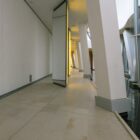Concrete Repair and Finishes:
Concrete Repair and Finishes products and treatments constitute a sustainability approach of prolonging the life of buildings without reconstruction and demolition. Concrete Repair and Finishes are necessary to repair homes, buildings, and large structures. Concrete Repair and Finishes include products utilized to cover existing damaged concrete layer and provide additional finishing to the surface. These products overcome the costs required to build an entirely new surface to repair small damages to concrete. However, larger cracks and damage from water and freezing must not be repaired using concrete repair and finishes.
Causes of Concrete Failure:
Changing environmental conditions, extreme temperatures, and weather affect the concrete structure of a building over the span of time. The causes are classified into the following categories:
- Mechanical damage: Seismic activity, overloading, explosion, etc.
- Corrosion: Chlorides, Carbonation, stray voltage, etc.
- Chemical Exposure: Bacterial and alkali reactions, etc.
- Physical damage: water percolation, freeze-thaw, abrasion, etc.
- Construction faults: Defected design, lack of maintenance, faulty material, etc.
Concrete Repair and Finishes are necessary to restore durable, structural integrity, enhanced geometric and aesthetic appearance.
Treatments for Concrete Repair and Finishes:
There are various methods developed and utilized for the treatment of cracks and damaged concrete. Each treatment varies in specification and products according to the type and intensity of the damage. Some methods are described as follows:
- Micro-Toppings:
The micro-topping method involves applying a thin layer ( approx. 1/8 in.) of polymer-based and sanded concrete. It is essential to consider the minute details while applying micro-toppings as they are thin-layered and dry quickly, which impacts the final appearance. It takes 36-42 hours of curing for the final finishing appearance of concrete. A sealant is applied to the micro-topping layer because the layer is porous and can accumulate dirt that is not cleanable. More than 2 coats of micro-toppings or one coat without sand can also be applied, depending upon the level of finishing smoothness desired.
- Stamped Concrete:
The Stamped Concrete method is utilized mainly over the surface, for both external and internal walls. The treatment involves applying concrete over an already stamped surface treated with textures to give an appearance of brick, tile, stone, etc. It is also applied in thin layers (1/4-5/8 in.) but consists of more sand than micro-toppings. Stamped concrete treatment is durable, economical, comes in a variety of colors, and provides a rougher final appearance. A sealant is used afterward, to give smooth finishing.
- Self-leveling: Topping and Underlayment:
Self-leveling treatments involve the application of a thickened concrete layer to cover the rough surface and deeper damages. This type of treatment also comes in a variety of colors or can be tinted and cured, using dyes. The dense layer of concrete ( ¼-1 in. ) provides longer durability and plumage with the existing concrete layer. Self-Levelling is categorized into toppings and underlayment. Underlayment is the material applied on concrete subfloors to smoothen it before covering it with the floor. Toppings are the final finished product that acts as an actual floor and do not require additional covering.
Factors to Consider for Concrete Repair:
There are certain factors and conditions that need consideration for concrete repair to gain effective and durable results. These are:
- Foundations must be adequately prepared and made concrete-ready.
- Clean the joints and eliminate damaged concrete.
- Forms must be grouted, strong, and properly aligned.
- Reinforced steel structures and other embedments must be clean and strongly held in their respective position.
- The equipment required for applying repair and finishing products must be available on-site, and in the state of being utilized without creating errors.
Concrete Admixtures:
Concrete Admixtures are the additional products that, when added in concrete, increase the strength, life, and durability of concrete. These may be chemicals or mineral products. Concrete Admixtures have been classified by ASTM into the following categories, depending upon their functions:
- Type A: Water Reducers
- Type B: Set Retarders
- Type C: Accelerators
- Type D: Water Reducers and Retarders
- Type E: Water Reducers and Accelerators
- Type F: High Range Water Reducers
- Type G: Water Reducers and Retarders (High Range)
Shrinkage and Water Reducing admixtures, although utilized in the market, are not categorized by ASTM. Additionally, concrete admixtures for grouting, air-entraining, and prevention of corrosion are also utilized. Concrete admixtures lessen or sometimes eliminate the requirement of concrete repair and finishes because of the additional qualities added in the concrete by admixtures.
What we provide:
Ozonecc offers a variety of products to be utilized as Concrete Repair and Finishes. Our products vary in consistency from polymer modified and epoxy-based products to thixotropic resin products. These products are water-proof and provide long-term strength for repairing several small and large structures. Ozonecc provides easy-to-use products along with their nature, handling, storage, application method, and precautionary measures. The company offers consultancy and technical assistance to repair concrete structures.






